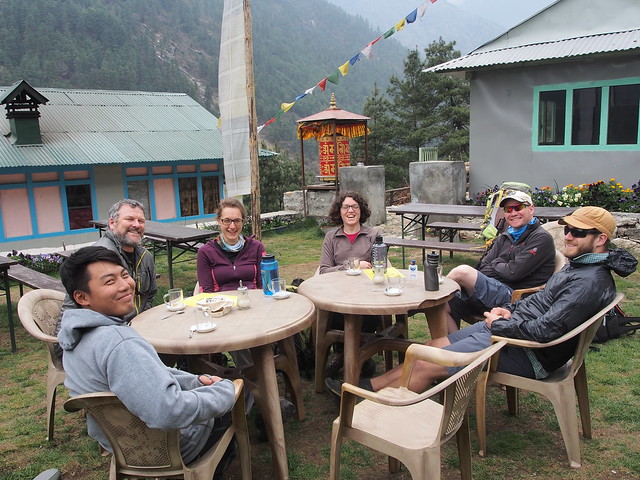Aberystwyth glaciologists successfully drill the world’s highest glacier

Aberystwyth University members of the EverDrill project, Katie Miles and Professor Bryn Hubbard, flying the Aber flag at drill site 3 on the Khumbu glacier near Everest Base Camp.
30 June 2017
Climate change scientists have successfully completed the first ever drilling of the world’s highest glacier.
The team of scientists from Aberystwyth University and the University of Leeds undertook a six week mission to the Khumbu glacier in the foothills of Mount Everest.
Working at an altitude of roughly 5000 metres, the team used a specially adapted car wash unit to drill into the 17km-long glacier at three different points.
Sensors for recording the glacier’s internal temperature and how it flows were installed to collect data.
At the highest point near Everest base camp, the team spent three days drilling 150 metres down into the glacier before recording its internal structure using a 360o camera.
The expedition was a part of the EverDrill project led by the University of Leeds with the drilling led Professor Bryn Hubbard from Aberystwyth University.
The car wash unit used by the team for drilling produces a jet of hot water at a pressure of up to 120 bar - enough to penetrate road tarmac.
Professor Hubbard said: “Working in the field is challenging at best, but on this occasion our equipment worked as well as can be expected at such high altitude, where the air is so thin. At the outset we were expecting to encounter a lot of debris in the form of rocks and stones in the glacier. These would have made drilling more challenging. As things turned out, drilling at the highest and lowest points was relatively trouble free, which in itself tells us quite a bit about the internal structure of the glacier.”
At the lower end of Khumbu, the team successfully drilled 45 metres down to the bed of the glacier.
At the mid-point, the team encountered rocks and mud sediment which restricted drilling to between 15 and 25 metres.
Data collected during the expedition will be combined with satellite images to understand how the glacier moves and changes over time, and how it might respond to anticipated climate change.
Situated in a region notorious for its seismic activity and prone to large earthquakes, the Khumbu and surrounding area are the source of water for around 40% of the world’s population.
However, dams and lakes that form on the glacier present significant risk of flash flooding for people living down-stream.
Professor Hubbard said: “Understanding what actually happens inside these glaciers is critical to developing computer models of their response to anticipated climate change. Equally important is developing a better understanding of how they flow so that we can better predict when dams that form on these glaciers are likely to be breached, releasing life-threatening volumes of water to the valleys below. This is a real risk in the Himalayas as it is in other regions such as the Andes, and has the potential to endanger the lives of thousands of people.”
Dr Duncan Quincey, leader of the EverDrill project said: “This is the first time anyone has the opportunity to gather data from below the surface of Khumbu. By understanding the glacier’s internal structure, temperature and flow, scientists can better predict how this glacier and others in the region will respond to climate change over the coming decades.”
Professor Hubbard was accompanied by Aberystwyth University postgraduate researcher Katie Miles from the Centre for Glaciology, Dr Duncan Quincey from the School of Geography at Leeds and Postdoctoral Researcher Evan Miles.
Before starting to drill the team made their way up to the glacier over a period of eight days to acclimatize to the lower levels of oxygen at 5000 metres.
Members of the team will return to the drill sites on Khumbu in autumn 2017 to retrieve temperature sensors and to investigate how it moves during the wet season.
Current satellite data suggests that the glacier moves more during the monsoon season and the team are hoping to corroborate this data with actual data collected from the glacier itself.
The team is planning a second drilling mission to the Khumbu glacier in spring 2018.
Dr Quincey is overseeing the remote sensing (satellite imagery) aspect of the project.
Both the drilling work and the remote sensing are funded by the Natural Environment Research Council, NERC.
Professor Bryn Hubbard
Professor Bryn Hubbard was awarded the Polar Medal in January 2016 for his work as a “Polar scholar in glaciology, glacial geology and the structure and motion of ice masses”.
The 2018 Himalaya study will be his 30th consecutive year to include a period of glaciological fieldwork.
Since 1988, Professor Hubbard has worked in Antarctica on six occasions, studied high altitude glacier movement in the Peruvian Andes on three occasions, worked in Greenland on five occasions and on Svalbard eight times, as well as Canadian Arctic and Norway.
Before researching at the world’s more exotic ice masses, he carried out fieldwork in the European Alps, leading or participating in field camps on perhaps 20 occasions.




